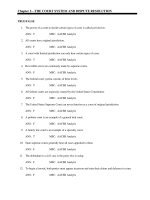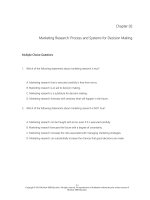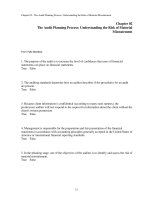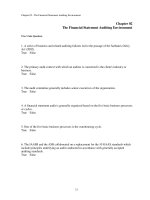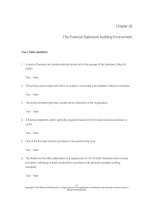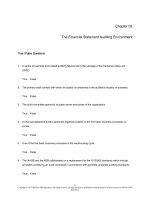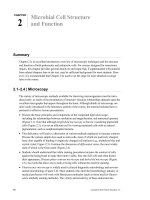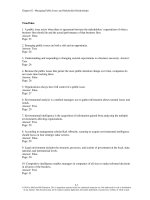Conformity and conflict readings in cultural anthropology 14th edition spradley test bank
Bạn đang xem bản rút gọn của tài liệu. Xem và tải ngay bản đầy đủ của tài liệu tại đây (134.65 KB, 7 trang )
PART 1
CULTURE AND ETHNOGRAPHY
The introduction to Part 1 discusses the concept of culture and the nature of ethnographic
fieldwork with special emphasis on the following definitions.
KEY DEFINITIONS
Culture is the acquired (learned) knowledge that people use to generate behavior and interpret
experience.
Ethnography is the process of discovering and describing a particular culture.
A microculture is a system of cultural knowledge characteristic of a subgroup within a larger
society.
Tacit culture is culture that is not coded in language by a people, such as speaking distances.
Explicit culture is culture that people are consciously aware of and can talk about.
An informant is an individual from whom anthropologists learn a culture.
A respondent is an individual who responds to survey questions normally associated with
survey research.
A subject is a person who is observed by social scientists conducting experimental social or
psychological research.
Naive realism is the belief (often unconscious) that people everywhere see the world in the same
way.
Ethnocentrism is the belief and feeling that one's own culture is best.
Culture shock is a state of anxiety that results from cross-cultural misunderstanding.
Detached observation is a research approach in which investigators observe human behavior
and create their own categories and theories to describe and explain it.
QUESTIONS
True or False?
F
1.
Culture is the patterned behavior characteristic of a group of people.
T
2.
Detached observation is a research approach in which investigators observe human
behavior and create their own categories and theories to describe and explain it.
F
3.
A microculture is the patterned behavior characteristic of a subgroup within a larger
society.
T
4.
An informant is what anthropologists call the individuals from whom they learn a
culture.
F
5.
Tacit culture is cultural knowledge that informants consciously hide from the
anthropologist during fieldwork.
Multiple Choice
1.
Sir Edward Burnett Tylor is known for his early definition of
a. ethnography.
* b. culture.
c. naive realism.
d. culture shock.
e. detached observation.
2.
When they do ethnographic fieldwork, anthropologists interview
a. respondents.
b. subjects.
* c. informants.
d. participants.
e. objects.
3.
The process of discovering and describing a particular culture is called
a. interviewing.
b. ethnology.
c. participant observation.
* d. ethnography.
e. ethnocentrism.
4.
The view that all people see and understand the world in the same way is called
* a. naive realism.
b. culture shock.
c. ethnocentrism.
d.
e.
5.
arbitrariness.
detached observation.
The belief and feeling that one's own culture is best is called
a. culture shock.
b. cultural relativism.
c. naive realism.
d. detached observation.
* e. ethnocentrism.
Article 1
Ethnography and Culture
JAMES P. SPRADLEY
Summary In this introductory chapter from his book, Participant Observation, Spradley defines
and emphasizes the importance of ethnographic fieldwork and the concept of culture.
Ethnography is the work of describing a culture. It requires the discovery of the native or
insider’s point of view. Cultural behavior consists of the actions generated by cultural
knowledge. Cultural artifacts, based on cultural behavior and cultural knowledge, are the things
people make or shape from natural resources. Culture, itself, is the socially acquired knowledge
that people use to generate behavior and interpret experience. Different cross-cultural
interpretations of the same event easily cause misunderstandings. Culture may also be explicit
(part of our conscious awareness) or tacit (outside awareness). The meaning of things for
members of a group is at the heart of the culture concept, a point related to Blumer’s notion of
symbolic interaction. Spradley concludes by characterizing culture as a map, a guide to action
and interpretation.
QUESTIONS
True or False?
F
1.
Spradley defines culture as behavior, artifacts, and knowledge.
T
2.
Anthropologists, such as George Hicks, look for inside meaning when they do
ethnographic research.
F
3.
Tacit culture refers to cultural knowledge that informants consciously hide from the
ethnographer.
T
4.
Herbert Blumer developed a theory of symbolic interaction.
F
5.
The concept of “explicit culture” is a key part of Herbert Blumer’s theory of symbolic
interaction.
T
6.
Spradley argues that culture is more like a map, guiding human action, rather than a
strict set of rules requiring specific behavior.
Multiple Choice
1.
According to Spradley, the term “ethnography” refers to
a. cross-cultural explanation.
* b. the discovery and description of the culture of a particular group.
c. the statistical testing of hypotheses in the field, using survey questionnaires.
d. the discovery of ethnic subgroups within complex societies.
e.
the process of cross-cultural classification, comparison, and explanation.
2.
According to Spradley, culture, itself, is a kind of
a. behavior.
b. artifact.
* c. knowledge.
d. symbolic interaction.
e. ideal system.
3.
According to Spradley, the belief that people everywhere interpret the world in the same
way is called
* a. naive realism.
b. ethnography.
c. cultural behavior.
d. explicit culture.
e. tacit culture.
4.
Which of the following is the best example of an action based on a tacit cultural rule for
members of U.S. society?
a. chewing with one's mouth closed
b. driving on the right side of the street
c. giving your father “his” chair in front of the family television
* d. moving to the opposite side of an elevator when there is only one other person in it
e. formatting a business letter
5.
The idea that human beings act toward things on the basis of the meanings they have for
them is a tenet of
a. naive realism.
b. explicit culture.
c. tacit culture.
d. ethnographic research techniques.
* e. symbolic interaction.
6.
According to Spradley, the actions generated by cultural knowledge are called
a. social control.
* b. cultural behavior.
c. cultural generation.
d. cultural artifacts.
e. explicit culture.
Article 2
Eating Christmas in the Kalahari
RICHARD BORSHAY LEE
Summary In this article, Lee describes a classic case of cross-cultural misunderstanding that
occurred near the completion of his fieldwork among the !Kung Bushmen. To thank the !Kung
for allowing him to live and work among them, Lee decided to donate an especially large ox for
them to eat at their annual Christmas feast. To his dismay, the !Kung seemed disappointed with
the animal he had chosen, claiming that it was too thin, old, and sick. Their attitude persisted
even after the butchered ox proved to be so large and fat that it fed 150 people for two days.
Only later did Lee discover that the !Kung customarily denigrate and ridicule hunters who have
killed large game in order to “cool” their potential arrogance. To Lee, the ox meant a gift, and in
American culture gifts should be reciprocated with thanks and appreciation. To the !Kung, the ox
was a large animal to be shared, something hunters contribute regularly. For them, the provider
must be kept in line lest he become impressed by his own importance (a position related to the
!Kung value on equality). Because of these different cultural interpretations of the same act,
cross-cultural misunderstanding resulted.
As a postscript to this article, remember that the !Kung were studied by Lee in the 60s; few live
as foragers today. For an update on the !Kung see the epilogue to article 11 by Lee and Biesele.
QUESTIONS
True or False?
F
1.
!Kung ridiculed the ox Lee gave them for their Christmas feast because the animal was
too thin and old.
F
2.
Lee's gift of a Christmas ox was ridiculed by the !Kung because he misunderstood their
criteria for a desirable animal.
T
3.
The !Kung ridiculed the ox given them by Lee for their Christmas feast because this is
the usual way they “cool” the arrogance of people who provide important things for
others.
T
4.
The !Kung regularly understate their own hunting achievements to avoid looking
arrogant.
F
5.
!Kung regularly express admiration for one another’s hunting achievements.
T
6.
The misunderstanding that Lee experienced with the !Kung was based on different
cultural meanings for Lee’s gift of a Christmas ox.
Multiple Choice
1.
!Kung expressed disappointment with the ox Lee gave them for the Christmas feast because
a. the animal was too thin and old.
* b. this was their way to “cool” a giver’s potential arrogance.
c. the animal came from an outsider.
d. they were afraid that Lee would take the animal back if they showed approval.
e. they were angry at Lee for intruding on their lives.
2.
The cross-cultural misunderstanding experienced between Lee and the !Kung occurred over
* a. the cultural meaning of the gift of an ox.
b. the criteria for defining what makes an ox desirable.
c. the way Lee gave them the ox.
d. the cultural meaning of oxen.
e. the poor condition of the ox.
3.
According to Lee, a !Kung hunter
a. eats all of a kill himself.
b. shares game only with his own family.
c. gives all the meat from an animal he has killed to the man who made the arrow he used.
* d. shares what he kills with others and expects them to reciprocate.
e. may do anything he likes with an animal he kills.
4.
According to Lee, when a !Kung hunter kills a large animal, he is likely to tell others
a. “I have killed a large giraffe.”
b. “I have killed a big one in the bush.”
* c. “I am no good for hunting. I just saw a little tiny one.”
d. “A giraffe happened to step in front of my flying arrow.”
e. “Come help me carry. There is much heavy meat.”
5.
The way the !Kung treated Richard Lee’s gift of a Christmas ox reveals their value on
a. individualism.
b. male dominance.
c. family solidarity.
d. identification with nature.
* e. equality.
6.
Lee acquired the ox he intended to slaughter for the !Kung Christmas feast
* a. from Herero pastoralists living nearby.
b. from a South African cattle rancher.
c. from the !Kung headman.
d. by catching it in the wild.
e. none of the above
